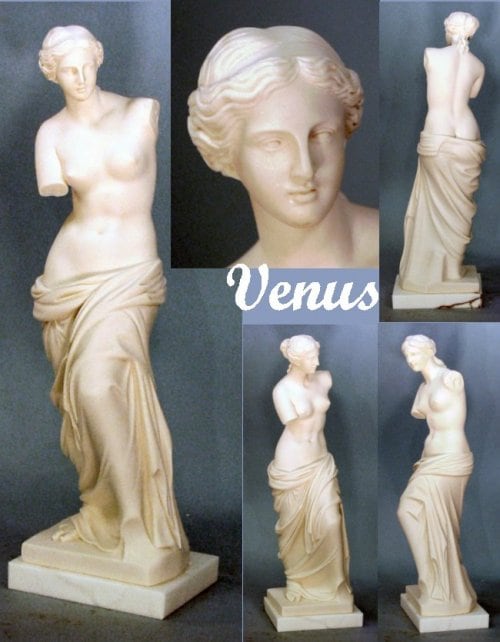|
 There
is no mistaking the classical elegance that has
made the Venus statue one of the most common sculptures
used in decorating today. There
is no mistaking the classical elegance that has
made the Venus statue one of the most common sculptures
used in decorating today.
At Statue.com, we are proud to offer an extensive collection of Venus statues ranging from replicas of the classical pieces above to more modern erotic sculptures. You will also find both traditional and some modern Venus sculptures in the Classical Sculptures Gallery and some large Venus statues in our Life Size Sculpture Gallery.
Whether known as Venus or her Greek name Aphrodite,
she is the goddess of love, beauty, and fertility.
She represents affection and the attraction that
binds people together in marriage. Her beauty
is said to have caused the Trojan War and she
was pursued by every God.
In Greek Mythology, her son Eros is the God of
love and sexual desire. Her Roman son, Cupid,
is the messenger of Love.
Venus de Milo Statue
The most famous Venus statue is the Venus de
Milo housed in the Louvre in France. Although
the sculptor is unknown and the date of origin
can only be estimated the second century B.C.,
it remains a masterpiece with few equals.
In the early 19th Century the statue was discovered
in an underground cavern on the Aegean island
of Melos by a farmer digging in his field. It
was missing its arms but it is believed that one
held a shield while the other held a mirror so
that she could admire her own beauty. After a
unique series of events, the French acquired the
statue and renamed it the Venus de Milo.
Birth of Venus
Coming from the sea, is this lovely statue of
the Birth of Venus. The ancient legends say that
Venus sprung from the foam of the sea. Her arrival
at the abode of the Gods threw Mount Olympus into
an uproar. Everyone was charmed by her beauty
and each asked her hand in marriage. This legend
was taken by Botticelli for his famous painting
The Birth of Venus, which now hangs in the Uffizi
gallery in Florence.
Venus by Canova
Canova carved the original Venus Italica to replace
the ancient Roman Medici Venus, seized by Napoleon
in 1802 from the Uffizi Gallery in Florence. In
the true Neoclassical spirit, Canova decided to
reinterpret the ancient work rather than carve
an exact replica. Drawing inspiration from other
classical statues of the goddess, he made several
significant changes in the figure; as a result,
his Venus appears more natural and her movement
more gentle than the Medici Venus. The Venus Italica
was immediately hailed as Canova's masterpiece
and a worthy successor to the ancient Venus. When
I saw this divine work of Canova, wrote the poet
Ugo Foscolo in 1811, I sighed with a thousand
desires, for really, if the Medici Venus is a
most beautiful goddess, this is a most beautiful
woman.
|